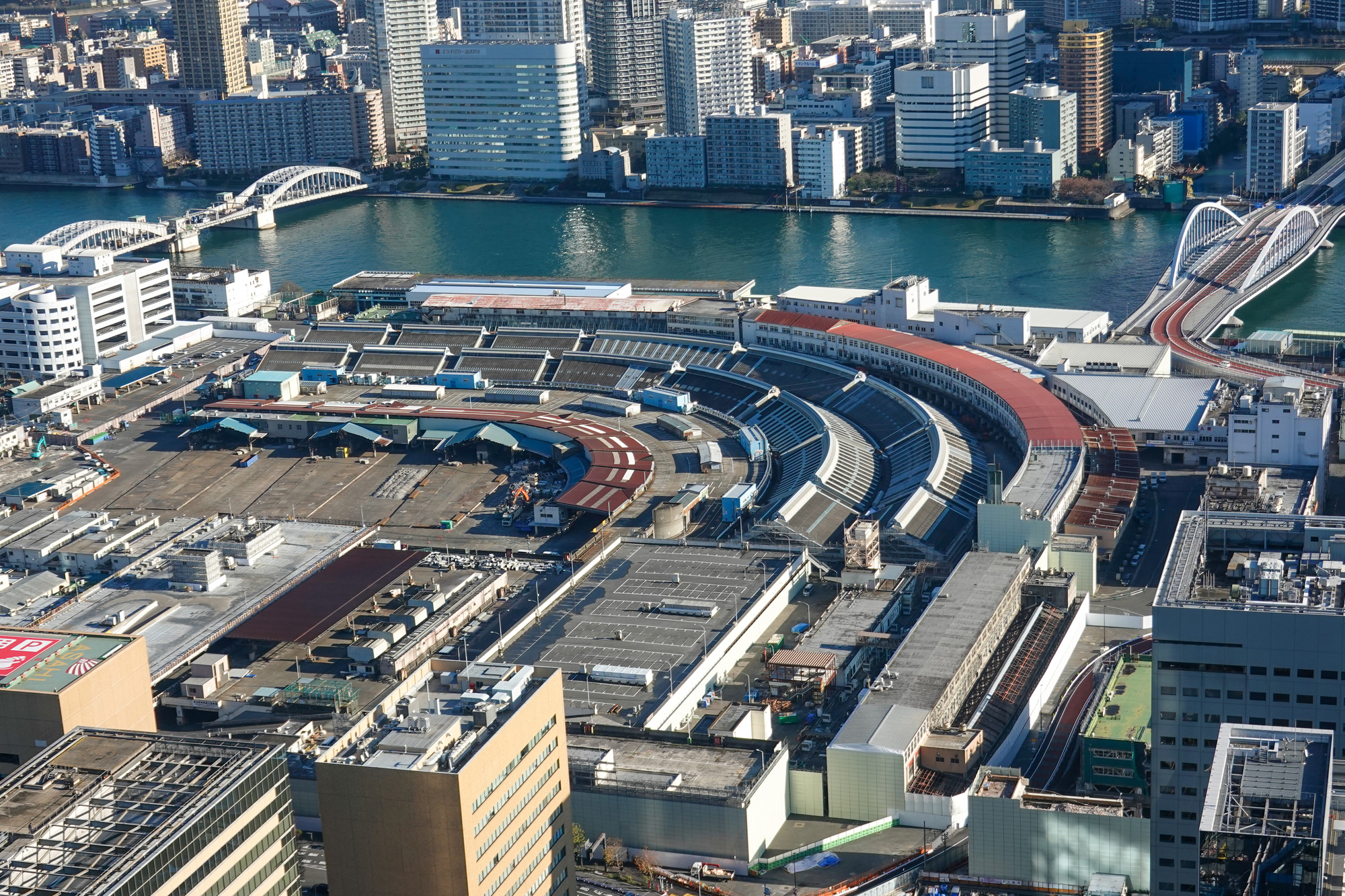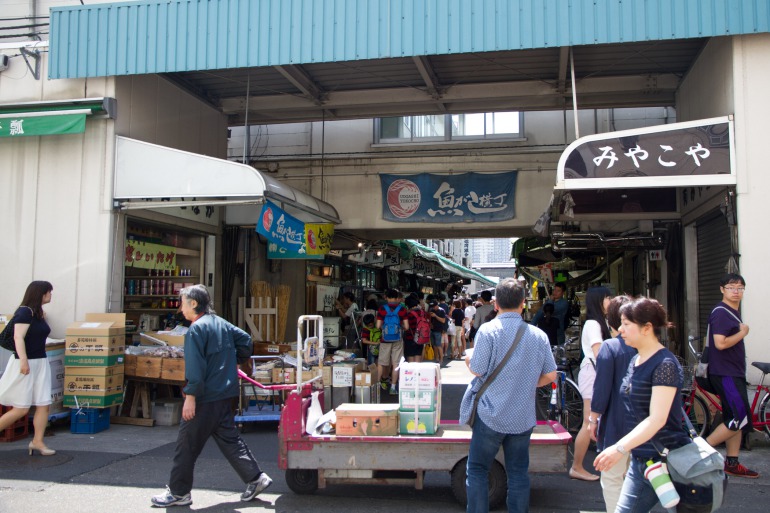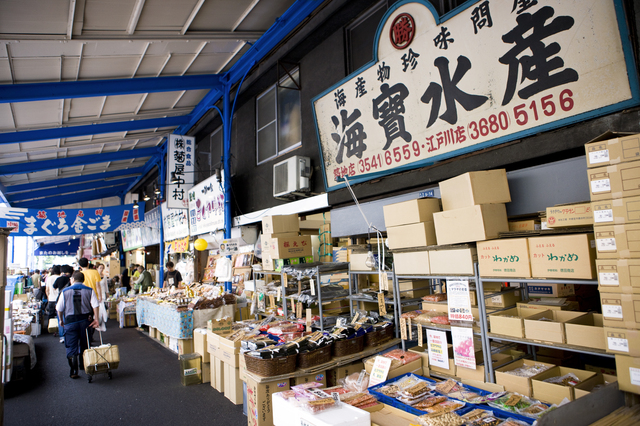Tsukiji Fish Market is not only a famous landmark for tourists. It is a living, breathing marketplace that has fed Tokyo, Japan, and the World with fresh marine produce. Tsukiji Fish Market continues to overflow with energy from the vendors and visitors, who all shares in their love and craving for seafood and sushi.
The excitement of visiting Tsukiji Fish Market remains, even after 2018 when the inner markets (where the famous tuna auctions took place) were moved to their current Toyosu location. The outer markets which have always served the public, flourishes with an unchanging flow of fish-lovers and tourists.
In this article, we will introduce Tsukiji Fish Market's history, and things to do there on your next visit!
History of Tsukiji Fish Market

Tsukiji Fish Market from above
Tsukiji before the Fish Market
Tsukiji was not a wholesale marketplace from the beginning. In 1657, after a large fire, land was constructed on a section of the Sumida River as a part of a post-fire recovery plan, and was named Tsukiji (hence the name Tsukiji – literally translating to “constructed land”). According to one historical record, the believers of the Honganji School of Shin Buddhism constructed Tsukiji to house Honganji, a shrine originally located in Asakusa. During the fire, Honganji went up in flames and was completely demolished, and later was moved to Tsukiji and reconstructed there.
Tsukiji in the Early Edo period
During the Edo period (1603-1867), the residents of Tsukiji were mostly samurai (warriors) and daimyo (feudal lords). As a result of the heavy population of samurai and daimyo, merchants opened up shops in Tsukiji and sold rice, coal and firewood to sell to them.
Westernization of Tsukiji
Reaching the late Edo period, when Japan began loosening up its sakoku (closed-border) laws, Tsukiji started to become more internationalized too. Plans of opening up settlements in Edo (Tokyo), and particularly in Tsukiji, for foreigners arose, due to its convenient location. Eventually, side by side with samurai training bases and naval academies, hotels and settlements specially made for foreigners opened up in Tsukiji. As the era was shifting from Edo to Meiji in 1869, borders opened up even more and more foreign businesses entered. Tsukiji was now home to foreign mission schools, hospitals, bakeries and much more, becoming an area that was constantly importing new Western ideals and technologies.
The Birth of Tsukiji Fish Market
Unfortunately in 1923, after the great Kanto earthquake, many parts of Tsukiji, including Honganji, were destroyed, which lead to a great change in the structure of the area. Streets and alleyways were reassigned and reconstructed accordingly, driving the foreign influence away from the streets. Many parts of Tokyo were destroyed and relocated, such as Uogashi, Tokyo’s popular fish market originally located in Nihombashi, which was moved to none other than Tsukiji.
Tsukiji Fish Market as the "Tokyoite's Kitchen"
Due to a rumor that business would prosper when run in the remains of a graveyard, the remains of Honganji’s burial grounds became a popular market area for the fishmongers. Eventually, over 500 fish markets were selling and trading fish in the remnants of the cemetery. Although activities were suspended in Tsukiji during the Second World War, businesses quickly resumed after the war ended in 1945. Tsukiji grew to become loved by locals, earning the well-deserved nickname “The Tokyoites’ Kitchen”, and is now overflowing with both locals and foreign guests.
As of 2018, the Inner "Jonai" Market has been moved to a new location in Toyosu. Currently, Tsukiji Fish Market is comprised only by the outer "Jogai" Market that has always served the public over the years. Many vendors continue to operate within the premises, with an unchanged passion and energy!
【Related Article】
More about Tsukiji Honganji Temple↓↓
Tsukiji Honganji Temple: An Exotic Twist to Japanese Buddhism
RELATED ARTICLE
Tokyo < Ginza / Tsukiji

Tsukiji Honganji Temple: An Exotic Twist to Japanese Buddhism Standing by the world-famous Tsukiji Fish Market is Tsukiji Honganji Temple. Combining the styles of India and Japanese Buddhism, Tsukiji Honganji Temple is a rare, exotic sight. Dive into the history and beauty of Tsukiji Hongaji Temple!
Shrines & Temples
Tsukiji's "Inner" vs. "Outer" Market: What's the Difference?
The Inner "Jonai" Market is a Wholesale Fish Market for Businesses

The "jo-nai" (場内), or inner market
The jo-nai, or inner market, is the real deal; this is where most of the wholesalers execute their sales. Sadly, this means that most of the inner market is inevitably closed to the public. Tourists must remember that Tsukiji is a real market that prioritizes efficiency and productivity, and not fully a tourist attraction. There is a small open area within the inner market opening at 10AM for public viewing.

Uogashi Yokocho
Also within the inner market is the Uogashi Yokocho, a small restaurant area packed with sushi restaurants. This is where you can find narrower yet famed restaurants like Sushi Dai, although due to its popularity, you may be subject to over a two-hour wait (longer or shorter, depending on the day).

Don't get ran over by these!
Tip: Make sure to stay aware of the mini-trucks and forklifts driving around the marketplace and make sure not to get in their way! They can (and will) run over you!
The Outer "Jo-gai" Market is open to the Public

"Jo-gai" Outer Market
The jo-gai, or outer market, sits outside of the auction hall, and is completely open to the public from 5AM to 3PM. The outer market houses many restaurants, and sushi is not your only option – ramen, tamagoyaki (Japanese style omelets), fried corn, and even matcha ice cream are available. Compared to the inner market, the outer market is less crowded and quieter, like a restaurant or food truck space.
Events
May: The Half-Price Market

Tamagoyaki (Japanese style omelets)
Once a year, usually in early May, Tsukiji’s outer market host a half-price market. During this day, all restaurants have one special dish on their menu that is half the cost of the usual. On this special day, you can eat kaisendon (bowl of rice covered with sashimi) and tamagoyaki (Japanese style omelets) to your stomach’s content, all for half the price.
June: Tsukiji Shishi Festival

The head of a shishi (lion)
Held in early June every three years, the Tsukiji Shishi festival is a special event. This festival dates back to 1659, when the host temple, Namiyoke Inari Jinja, was complete. Completing the shrine took several years and a lot of effort, as the area was prone to suddenly rising waves that would halt construction regularly. The completion of the shrine was met with praise and relief, and villagers celebrated with floats of the heads of “the tiger, which the clouds obey”, “the dragon, which the winds obey” and “the shishi (lion), with its roar, makes all creatures surrender”. The tradition lived on, ultimately becoming this festival. The official festival is held every three years, with a smaller version of it held annually.
August: Hongan-ji Bon-odori Festival

Bon-odori festival decorations
Tsukiji Hongan-ji’s bon-odori festival combines the gourmet charms of Tsukiji and Japanese traditional festival dancing, bon-odori. This self-proclaimed “most delicious bon-odori festival in Japan” proves themselves right by serving non-typical festival foods such as steak, yakitori, motsu-ni (simmered beef intestines) and tamagoyaki. You can get a taste of bon-odori and great Tsukiji eats at this festival, which takes place annually, usually in the beginning of August.
How to get to Tsukiji Fish Market
Nearest station: Tsukijishijo Station 築地市場駅 (Toei Oedo Line E18)
From Shinjuku Station 新宿駅
【Shinjuku Sta.】Toei Oedo Line / for Tochomae
→【Tsukijishijo Sta.】about a 5-minute walk from Exit A1
From Tokyo Station 東京駅
【Tokyo Sta.】JR Yamanote Line / for Shinagawa
→【Hamamatsucho/Daimon Sta.】Toei Oedo Line / for Tochomae
→【Tsukijishijo Sta.】about a 5-minute walk from Exit A1
From Narita Airport 成田空港
【Narita Airport Sta.】Narita Sky Access Express Line / for Haneda Airport Domestic Terminal
→【Daimon Sta.】Toei Oedo Line / for Tochomae
→【Tsukijishijo Sta.】about a 5-minute walk from Exit A1
From Haneda Airport
【Haneda Airport Sta.】Tokyo Monorail Express / for Hamamatsucho
→【Hamamatsucho / Daimon Sta.】Toei Oedo Line / for Tochomae
→【Tsukijishijo Sta.】about a 5-minute walk from Exit A1
Nearby Destinations
Tsukiji Honganji Temple
At a walking distance of 3 minutes from Tsukiji Market, Tsukiji Honganji Temple is Japan's first Indian Buddhist building. It has gotten a large amount of interest for its unique outer appearance. The original temple was built in Asakusa, however, ever since it was burned down in a fire, the Tsukiji Honganji has become its symbolic building.
There are english informational tours on Saturdays and Sundays from 5:30pm to 7:30pm. There are also pamphlets in Japanese, English, Chinese, Korean, and German.
Hamarikyu Gardens
At the Hamarikyu Gardens, you can enjoy a completely different atmosphere from the Tsukiji Market. This garden has been in operation since the Edo period. Out of all the gardens, the Peony Garden is the most famous. Also, the cherry blossoms that bloom in the spring add the final touched needed to fulfill the absolute Japanese atmosphere. It is a 15 minute walk from Tsukiji Market.
Namiyoke Inari Shrine
Namiyoke Inari Shrine enshrines a powerful god that is believed to be able to remove waves, therefore, this shrine protects the area from water related disasters. Along with water disaster protection, the Namiyoke Inari Shrine is also good for happiness, prospering business, and construction safety. This shrine also puts on the Lion Festival at Tsukiji. The shrine may possibly move with the Tsukiji Market, so please come visit the shrine as soon as possible!





_600x400.jpg)







_600x400.jpg)















_600x400.jpg)


